What is salinity?
Absolute (or ideal) salinity is the mass fraction of salts in seawater1. In practical terms, salinity is expressed as PSU (practical salinity units) which are based on water temperature and conductivity measurements1. Salinity used to be expressed in parts per thousand (ppt). For oceanic seawater, ppt and PSU are very close.
Salinity of estuaries usually increases away from a freshwater source such as a river (Figure 1 and 2), although evaporation sometimes causes the salinity at the head of the estuary to exceed seawater. The vertical salinity structure and the nature of salinity variation along the estuary (i.e. how rapidly salinity varies in the vertical and horizontal) are the defining features of the salinity structure of coastal waterways (Figure 2).
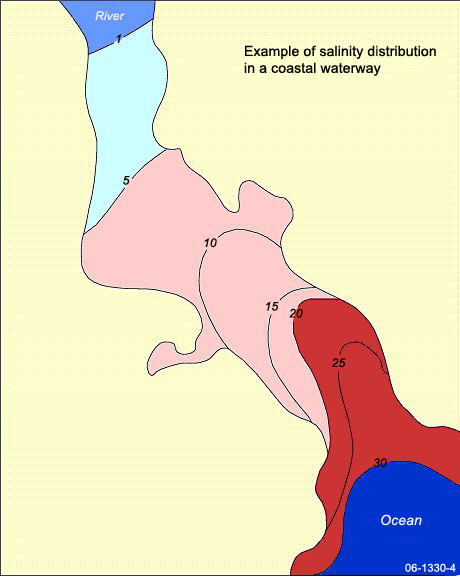
Figure 1. Plan view of the salinity distribution of a hypothetical estuary in which salinity (as PSU) increases away from the freshwater source.
Salinity regimes
There are four main characteristic types of salinity distributions in coastal waterways: stratified; partially mixed and fully mixed and inverse (Figure 2).
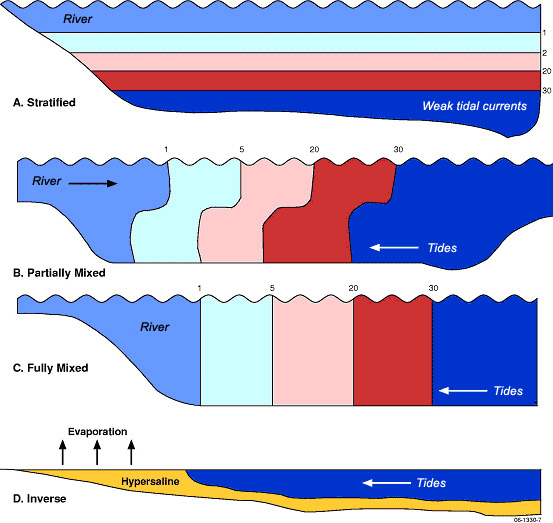
Figure 2. Sections through hypothetical coastal waterways showing the four salinity regimes in coastal waterways.
Stratified conditions
Stratified coastal waterways are characterised by a distinct increase in salinity with water depth (Figure 2A). Stratification occurs when riverine flow is sufficient to produce a plume of low-density freshwater (1000 kg m-3 at 20oC) which can flow over higher-density seawater (1025 kg m-3 at 20oC), and where tidal currents and waves are not strong enough to mix the water column (e.g. in wave-dominated estuaries). Such conditions can lead to anoxic and hypoxic events because bottom waters can become isolated from dissolved oxygen enriching processes, including gas exchange across the water surface and photosynthesis by plants in shallow water.
Partially mixed conditions
In partially mixed coastal waterways, tidal currents generate turbulence which promotes vertical mixing (Figure 2B). However, the tidal currents are of insufficient strength to fully mix the water column, and salinity varies both vertically and horizontally.
Fully mixed conditions
Fully mixed conditions occur in coastal waterways in cases where tide, river or wave energy produces enough turbulence to mix the water column (Figure 2C). In this case, salinity is uniform through the water column, but varies between the riverine and oceanic ends of the estuary.
Inverse estuary
High evaporation rates in the presence of low freshwater inflow can lead to hyper-salinity in tidal embayments and wide shallow estuaries. Estuarine water can become denser than oceanic waters under these conditions (Figure 2D), and thus sink forming a highly saline bottom layer that flows seaward. Seawater of lower salinity flows into the estuary over the top of this layer. Some Australian examples of inverse estuaries include the Coorong, Gulf of Saint Vincent and Spencer Gulf.
Dynamic nature of salinity structure
The Fitzroy Estuary and Keppel Bay in Central Queensland illustrate the dynamic nature of the salinity structure in most estuaries and some of the factors that influence it2. The Fitzroy River which flows into the head of the Fitzroy Estuary is highly seasonal with flows typically occurring as a series of events of several weeks duration during the summer. During the times of river flow the saltwater is often pushed right out of the estuary rendering it fresh. The waters of Keppel Bay are also freshened by the influence of water from the river (Figure 3ab). If the flow volume is large enough the water of Keppel Bay can become significantly stratified in salinity for some time until the tidal currents reduce this stratification and well mixed conditions prevail. The water within the estuary itself is always well mixed due to the strong tidal currents there.
Gradually in the months following the cessation of river flows, the freshwater is mixed by the tides and winds out of the estuary and bay and replaced by more oceanic water from offshore, and the salinity increases. After a prolonged period of no river flow during the winter months, evaporation near the coast and in the estuary causes the salinity there to be higher than offshore (Figure 3c). Thus, through the seasons, the estuary switches from a type which is well mixed with freshwater landward (Figure 3ab) to the inverse type (Figure 3c). Keppel Bay can stratify at times, but is also well mixed most of the time.
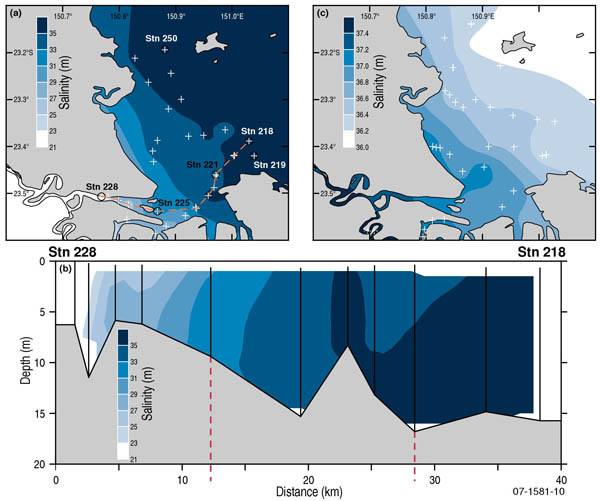
Figure 3. (a) Depth-averaged salinity measured during February 2005 in the Fitzroy Estuary and Keppel Bay after approximately one estuary volume of freshwater entered the Fitzroy estuary32. (b) Longitudinal salinity section across a transect starting within the Fitzroy Estuary and running along the shipping channel out of the mouth towards the northeast of Keppel Bay (Feb 2005)32. Salinity levels were lowest near the coast and generally increased in an offshore direction away from the mouth of the Fitzroy Estuary due to the discharge from the river3. The largest horizontal gradient is within the mouth region. (c) Depth-averaged salinity measured in the Fitzroy Estuary and Keppel Bay during August 200432. The occurrence of the higher salinities near the coast during the dry winter-spring months (c) is likely to be due to evaporation along the coast, in the tidal creeks, and in the Fitzroy Estuary.
What causes salinity regimes in coastal waters to change?
- The salinity distribution within coastal waterways reflects the relative influx of fresh water supplied by rivers, and marine water supplied by exchange with the ocean (Figure 1). Salinity levels fluctuate with the penetration of tidal flows, and with mixing of fresh water and marine water by wind and currents. Freshwater discharges to Australia’s coastal waterways are mainly episodic4, and are primarily controlled by conditions in the catchment including rainfall patterns, vegetation type and cover, topography, catchment area, and geology. Climatic factors may vary seasonally and inter-annually (e.g. with El Nino Southern Oscillation events). Entrance size (and seasonal closure in some areas) and sea level dictate marine water exchange, and the extent to which salinity can build up within the coastal waterway due to evaporation during times of low river flow56.
- Decreased freshwater inflows, due to the diversion of rivers and streams into impoundments, lead to the dissipation of salinity gradients and extended periods of elevated salinity in the landward sections of the estuary7. Both the vertical and longitudinal salinity distributions will occur with resulting changes in the circulation and mixing characteristics of the estuary.
- Large incursions of stormwater runoff can severely depress normal salinity levels in inshore areas.
- Engineering works such as trained entrances and dredged channels increase the water exchange between the estuary and the ocean (increased flushing). This has implications for salinity levels in a coastal waterway.
Importance of salinity
Salinity is important in coastal waterways for the following reasons:
- Salinity is a dynamic indicator of the nature of the exchange system. The salinity of the water within the estuary tells us how much fresh water has mixed with sea water. Also, plots that show the relationship between salinity and other soluble substances (e.g. nutrients) can be used to demonstrate the dynamic or conservative nature of those substances in ‘mixing plots’;
- Salinity is an important determinant of the mixing regime (see Figure 2 ) – because of the density variation associated with salinity variation, salinity stratification tends to inhibit vertical mixing in an estuary; which can have important implications for dissolved oxygen concentrations.
- The circulation with estuaries and coastal regions can derive from or be strongly influenced by the density variation associated with salinity. In effect, dense saline water tends to flow under fresh water.
- Salinity is an important ecological parameter in its own right; and it is important in some chemical processes (discussed below).
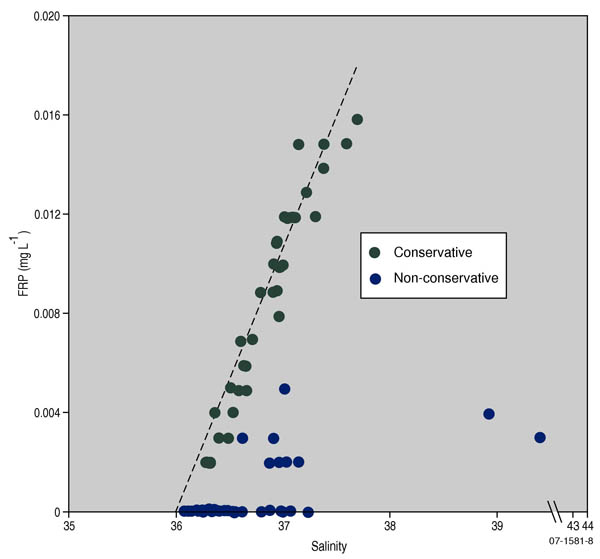
Figure 4. Mixing diagram (FRP versus salinity) for August 2004 in Keppel Bay3. The “green” samples follow the linear trend-line and behave conservatively with respect to salinity. The “blue” samples do not confirm to the linear trendline and thus are non-conservative with respect to salinity. Therefore, the concentrations of these nutrients are not determined by mixing rates, but rather by algal uptake rates.
Ecological importance
Most aquatic organisms function optimally within a narrow range of salinity (see example in Figure 5). When salinity changes to above or below this range, an organism may lose the ability to regulate its internal ion concentration. Indeed, ‘osmoregulation’ may become so energetically expensive that the organism dies due to the direct physiological effects or it becomes more vulnerable to biotic pressures such as predation, competition, disease or parasitism. Consequently, shifting salinity distributions can affect the distributions of macrobenthos 8 as well as those of rooted vegetation (e.g. seagrasses) and sessile organisms9.
The nature of the longitudinal salinity gradient (and the position of certain isohalines) is an important factor in the successful recruitment of larval and juvenile fish1011. Salinity is also an important control on the types of pathogenic organisms and invasive species that can occur in a coastal waterway, on the types of species that can occur in algal blooms1213, and on the activity of nitrifying and denitrifying bacteria14. As a general rule, widely-varying salinity regimes tend to select for a low-abundance and low-diversity suite of species, which are adapted to a broad range of ionic concentrations (e.g. euryhaline species).
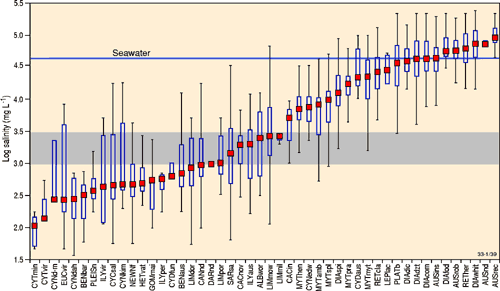
Figure 5. These box and whisker diagrams show salinity preferences in log units (medians = red box), ranges and preferred salinity ranges (i.e. range between the 25th and 75th percentiles) of ostracods (small crustaceans) found in lakes in south-eastern Australia. Salt concentrations in these lakes range from ~0.05 – 250 ppt, and changes in ostracod species composition track the salinity changes [modified after 9]. Note that in this example, salinity was calculated from the sum of the weights of the major ions (e.g. Na+, Mg2+, Ca2+, K+, Cl-, SO42- and HCO3-+CO32-).
Chemical processes
Sediment underlying freshwater can retain more exchangeable ammonium (NH4+) than sediment underlying saline water, because cations compete with NH4+ for negatively charged binding sites in the sediment 1415. More metals may also enter solution as salinity (and water hardness) increases because calcium and magnesium ions compete for binding sites on clay-organic particle surfaces, and this can interfere with the complexation and adsorption of metals16. However, increasing salinity usually causes a reduction in dissolved metal concentrations because the clay-organic particles form flocs with high settling rates which remove the attached metals from the water column. Flocculation occurring as salinity increases along an estuary can lead to settling of suspended particles and clarification of the water column.
Considerations for measurement and interpretation
The accepted method for determining the salinity of marine waters is by measuring the conductivity (EC) and temperature of the waters, then calculating the value of salinity using standard equations. A depth determination is also required for greater accuracy in calculation of salinities in deeper water.
Salinity is calculated using the ratio of the conductivity of the marine water to the conductivity of a standard solution of pure water and potassium chloride (KCl) at 15oC and one standard atmosphere in pressure, and in which the mass fraction of the KCl is 32.4356×10-3. This ratio is called the K15 value, and is used to calculate salinity on the Practical Salinity Scale 197817. As a ratio of conductivities has no units, the calculated salinity is also dimensionless. Thus for practicality, salinity is assigned Practical Salinity Units (PSU). A salinity of 35.000 has a K15 of 1 and is the salinity of standardised North Atlantic marine water that is slightly diluted. This is the accepted standard for high accuracy calibration of salinity determining instrumentation, and is sold with the appropriate recognition of the International Association for the Physical Sciences of the Ocean (IAPSO) as the IAPSO Seawater Standard.
The main advantage of using PSU is that marine waters from around the world can be compared on a common scale. Strictly speaking, this comparison is only robust in open marine waters. There can be problems with the Practical Salinity Scale 1978 in estuaries because the ion composition of freshwater inflow is often different than that of seawater18, and the conductivity measurement is influenced by ion composition. One should therefore exercise caution in how the acquired data and calculated salinities are used. For example, serious problems may occur if these data are used for highly accurate density calculations. When abundant freshwater inflow is apparent, one might consider measuring salinity from the sum of the weights of the suite of major, minor ions, and trace constituents. Suites of major ions (e.g. Na+, Mg2+, Ca2+, K+, Cl-, SO42- and HCO3-+CO32-) are commonly used on their own, but incur small charge-balance errors.
In practice the ratio of the waters and KCl solution are not measured. Instead, calibrated sondes and probe measure the conductivities, temperatures and depths. These values are used to calculate the salinity in accordance with the Practical Salinity Scale 1978. Some sondes do not provide a PSU calculation. A seawater equation of state calculator is available on the web, and can be used in such cases.
Salinity is determined in-situ using ‘environmental water quality’ or ‘oceanographic’ sondes (or probes). These instruments are often referred to as a CTD which is short for conductivity, temperature and depth (depth is derived from measurement of pressure). The conductivity probes have two or more electrodes made of stainless steel, gold or other suitable conductors that have a precise alternating voltage applied which is used to determine the conductance of the marine water in siemens per metre (S/m).
Some points to consider when making salinity determinations with sondes:
- Ensure that salinity values reported by the sonde are calculated in accordance with the Practical Salinity Scale 1978.
- Ensure the conductivity electrodes are cleaned appropriately often and calibrated at regular intervals. The length of the period between calibration and cleaning is determined by the user, as they develop familiarity with instrument and the environment under investigation.
- The conductivity electrodes can corrode slightly and may also acquire coatings from dissolved and suspended matter in the water column. The coatings and corrosion can increase resistance on the surface of the electrodes and reduce the accuracy of the determinations. This can be a significant problem when sondes are left in-situ for long periods of time (i.e. when they are used for continuous monitoring).
- Confirm the calibration of the sonde is stable across the range of temperatures in the environment in which the measurements will be taken because the electronics modules within the sondes may be sensitive to – and not corrected for temperature variation. Do not leave sondes in the sun prior to taking measurements because this will increase the time required for temperature equilibration.
- Most sondes report salinity to three decimal places, but the measure may only be accurate to one decimal place. It is best to determine the level of accuracy required prior to a survey.
- Always record the sondes report of temperature, conductivity and depth (if available) as these are the key values used to calculate salinity. Record reported salinity also. Be sure to routinely note the units of conductivity the sonde is reporting, as the sondes display can be toggled for different values. The last person to use the sonde may have been recording specific conductance (a value compensated usually to 25 C).
- The temperature response on most sondes is not instant and lags behind the conductance measurement. Thus equilibration time is required for an accurate measurement and determination of salinity. This requires the sonde to be stationary or very slow moving. Estuaries often have a significant thermal gradient which may be an issue if you are in a small boat rocking on the waves attempting to attain a stable measurement. In the open ocean, by comparison, the temperature response is usually rapid and thus this is less of an issue. Half a degree error in water temperature can cause a significant change in the salinity calculation.
- To determine the salinity value to a high degree of accuracy, a bench top precision salinometer, standardized seawater and a temperature controlled room away from strong electromagnetic fields is required.
Existing information and data
Since salinity/EC is a routine measurement, large amounts of data exist for estuaries and coastal waters from around Australia. The data is held by the collecting agencies (federal, state and local government, community groups and environmental consultants).
The seawater equation of state calculator allows you to compute PSU from water temperature, conductivity and water depth or pressure measurement (i.e. the UNESCO International Equation of State (IES 80) as described in117 ).
Conceptual models that show the interaction between ‘freshwater’ and marine water in embayments, and wave-dominated (deltas, estuaries and strandplains) and tide-dominated (deltas, estuaries and tidal creeks) coastal waterways are available in the OzEstuaries database.
The influence of oceanic exchange times and fresh water replacement times on salinity in different types of coastal waterways can be explored in the Simple Estuarine Response Models (SERM) developed by CSIRO.
More information on excess salt and excess freshwater .
Contributors
Ian Webster, CSIRO Land and Water
Ian Atkinson, Geoscience Australia
Lynda Radke, Geoscience Australia
- Fofonoff, N.P. 1985. Physical properties of seawater: A new salinity scale and equation of state for seawater. Journal of Geophysical Research 90 (C2), 3332-3342. ↩ ↩ ↩
- I. Webster, I. Atkinson, H. Bostock, B. Brooke, G. Douglas, P. Ford, G. Hancock, M. Herzfeld, R. Leeming, C. Lemckert, N. Margvelashvili, B. Noble, K. Oubelkheir, L. Radke, A. Revill, B. Robson, D. Ryan, C. Schacht, C. Smith, J. Smith, V. Vicente-Beckett, I. Webster, K. Wild-Allen. 2006. The Fitzroy Contaminants Project – A Study of the Nutrient and Fine-Sediment Dynamics of the Fitzroy Estuary and Keppel Bay. Cooperative Research Centre for Coastal Zone, Estuary & Waterway Management Technical Report #42. ↩ ↩ ↩ ↩
- Radke, L.C., Ford, P.W., Webster, I.T., Atkinson, I., Oubelkheir, K. 2006. Keppel Bay: Physical Processes and Biogeochemical Functioning. Cooperative Research Centre for Coastal Zone, Estuary & Waterway Management Technical Report #34. ↩ ↩ ↩ ↩ ↩
- Eyre, B. 1998. Transport, retention and transformation of material in Australian estuaries, Estuaries 21(4A), 540-551. ↩
- Roy, P. 2000. Structure and function of south-east Australian estuaries: A framework for addressing management issues. ↩
- Roy, P.S., Williams, R.J., Jones, A.R., Yassini, I., Gibbs, P.J., Coates, B., West, R.J., Scanes, P.R., Hudson, J.P., and Nichol, S. (2001). Structure and function of South-eastern Australian Estuaries. Estuarine and Coastal Shelf Science 53, 351-384. ↩
- Pierson, W.L., Bishop, K., Van Sendon, D., Horton, P.R., and Adamantidis, C.A. 2002. Environmental Water Requirements to Maintain Estuarine Processes, Environmental Flows Initiative Technical Report, Report Number 3, Commonwealth of Australia. ↩
- Boesch, D.F. 1977. A new look at the zonation of benthos along an estuarine gradient. pp. 245-266 in B.C. Coull (Ed.) Ecology of the marine benthos. University of South Carolina Press, Columbia, South Carolina, USA. ↩
- Alber, M. 2002. A conceptual model of estuarine freshwater inflow management. Estuaries 25 (6B), 1246-1261. ↩
- Odum, W.E. 1970. Insidious alteration of the estuarine environment. Trans. Am., Fish Soc. 88, 836-847. ↩
- Bulger, A.J., Hayden, B.P., Monaco, M.E., Nelson, D.M., McCormack-Ray, M.G. 1993. Biologically-based estuarine salinity zones derived from a multivariate analysis. Estuaries 16(2), 311-322. ↩
- Chan, T.U. and Hamilton, D.P. 2001. Effect of freshwater flow on the succession and biomass of phytoplankton in a seasonal estuary. Marine and Freshwater Research 52, 869-884. ↩
- Kirst, G.O., 1995. Influence of salinity on algal ecosystems. In ‘Algae, Environment and Human Affairs’, (Eds. W. Wiessner, E. Schepf and C. Starr), pp. 123-42, Biopress: Bristol , England. ↩
- Rysgaard, S., Thastum, P., Dalsgaard, T., Bondo Christensen, P., and Sloth, N.P. 1999. Effects of salinity on NH4+ adsorption capacity, nitrification, and denitrification in Danish Estuarine sediments. Estuaries 22(1), 21-30. ↩ ↩
- Seitzinger, S.P., Gardner, W.S., and Spratt, A.K. 1991. The effect of salinity on ammonium sorption in aquatic sediments: Implications for benthic nutrient recycling. Estuaries 14(2), 157-174. ↩
- Elder, J.F. 1988. Metal Biogeochemistry in Surface-Water Systems – A Review of Principles and Concepts. U.S. Geological Survey Circular 1013. ↩
- UNESCO 1981, a. Background papers and supporting data on the Practical Salinity Scale1978. UNESCO Tech. Pap. In Mar. Sci., No.38. ↩ ↩
- Radke, L.C. 2000. Solute divides and chemical facies in southeastern Australian salt lakes and the response of ostracods in time and space, Ph.D Thesis, Department of Geology, The Australian National University, pp. 232. ↩


